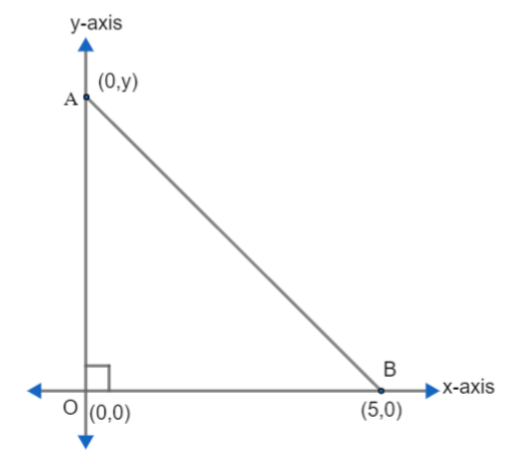
Answer
468.6k+ views
b> To solve this question, we will first observe the figure closely and see that what type of triangle is formed using axis. After observing that, it is a right angled triangle, we will use formula of area of triangle to solve this, which is given by \[A=\dfrac{1}{2}\times \text{base}\times \text{height}\] to get the base and height, we will use the distance formula given by \[\text{PQ=}\sqrt{{{\left( {{x}_{1}}-{{x}_{2}} \right)}^{2}}+{{\left( {{y}_{1}}-{{y}_{2}} \right)}^{2}}}\], where, \[\text{P=}\left( {{x}_{1}},{{y}_{1}} \right)\text{ and Q=}\left( {{x}_{2}},{{y}_{2}} \right)\]
Complete step-by-step solution:
Given that, the area of the triangle is 30 square units. Observing the figure, we get that, two of the sides of the triangle are formed at the x and y-axis.
We know that x-axis and y-axis are perpendicular to each other.
Therefore, these two sides of the given triangle are perpendicular to each other, hence we have an angle between them is ${{90}^{\circ }}$ So, we get that, the given triangle is a right-angled triangle.
The area of a right-angled triangle is given by,
\[A=\dfrac{1}{2}\times \text{base}\times \text{height}\]
We have figured as:

Let us denote the vertices of the triangle as OAB.
Then, the base of the triangle is OB and the height is OA. We will use the distance formula to calculate distance OB and OA.
Distance formula is given as:
\[\text{PQ=}\sqrt{{{\left( {{x}_{1}}-{{x}_{2}} \right)}^{2}}+{{\left( {{y}_{1}}-{{y}_{2}} \right)}^{2}}}\]
Where, \[\text{P=}\left( {{x}_{1}},{{y}_{1}} \right)\text{ and Q=}\left( {{x}_{2}},{{y}_{2}} \right)\]
Here, O = (0, 0)
A = (0, y)
And B = (5, 0)
Then, \[\begin{align}
& \text{OB=}\sqrt{{{\left( 5-0 \right)}^{2}}+{{\left( 0-0 \right)}^{2}}} \\
& \text{OB=}\sqrt{25} \\
& \text{OB=5} \\
\end{align}\]
And similarly using distance formula,
\[\begin{align}
& \text{OA=}\sqrt{{{\left( 0-y \right)}^{2}}+{{\left( 0-0 \right)}^{2}}} \\
& \text{OA=}\sqrt{{{\left( y \right)}^{2}}} \\
& \text{OA=y} \\
\end{align}\]
We have \[\text{Area of }\Delta \text{AOB}=\dfrac{1}{2}\times \text{base}\times \text{height}\]
\[\text{Area A=}\dfrac{1}{2}\times OB\times OA\]
Substituting the values of OB and OA we get, and area A = 30 square unit.
\[\begin{align}
& \text{Area A=30=}\dfrac{1}{2}\times 5\times y \\
& \Rightarrow 30=\dfrac{1}{2}\times 5y \\
\end{align}\]
Multiplying 2 on both sides, we get:
\[\Rightarrow 60=5y\]
Dividing by 5, we get:
\[\Rightarrow 12=y\]
Therefore, the value of y = 12 which is option D.
Note: The key point in this question is using area of triangle as \[A=\dfrac{1}{2}\times \text{base}\times \text{height}\] Here, the triangle is a right-angled triangle. Therefore we can apply this formula of area of the triangle. If it was a normal triangle other than the right-angled triangle then we cannot apply this formula. While applying the distance formula, even if students interchange the coordinates by mistake, they will not go wrong as there is a square and the result won't be altered.
Complete step-by-step solution:
Given that, the area of the triangle is 30 square units. Observing the figure, we get that, two of the sides of the triangle are formed at the x and y-axis.
We know that x-axis and y-axis are perpendicular to each other.
Therefore, these two sides of the given triangle are perpendicular to each other, hence we have an angle between them is ${{90}^{\circ }}$ So, we get that, the given triangle is a right-angled triangle.
The area of a right-angled triangle is given by,
\[A=\dfrac{1}{2}\times \text{base}\times \text{height}\]
We have figured as:

Let us denote the vertices of the triangle as OAB.
Then, the base of the triangle is OB and the height is OA. We will use the distance formula to calculate distance OB and OA.
Distance formula is given as:
\[\text{PQ=}\sqrt{{{\left( {{x}_{1}}-{{x}_{2}} \right)}^{2}}+{{\left( {{y}_{1}}-{{y}_{2}} \right)}^{2}}}\]
Where, \[\text{P=}\left( {{x}_{1}},{{y}_{1}} \right)\text{ and Q=}\left( {{x}_{2}},{{y}_{2}} \right)\]
Here, O = (0, 0)
A = (0, y)
And B = (5, 0)
Then, \[\begin{align}
& \text{OB=}\sqrt{{{\left( 5-0 \right)}^{2}}+{{\left( 0-0 \right)}^{2}}} \\
& \text{OB=}\sqrt{25} \\
& \text{OB=5} \\
\end{align}\]
And similarly using distance formula,
\[\begin{align}
& \text{OA=}\sqrt{{{\left( 0-y \right)}^{2}}+{{\left( 0-0 \right)}^{2}}} \\
& \text{OA=}\sqrt{{{\left( y \right)}^{2}}} \\
& \text{OA=y} \\
\end{align}\]
We have \[\text{Area of }\Delta \text{AOB}=\dfrac{1}{2}\times \text{base}\times \text{height}\]
\[\text{Area A=}\dfrac{1}{2}\times OB\times OA\]
Substituting the values of OB and OA we get, and area A = 30 square unit.
\[\begin{align}
& \text{Area A=30=}\dfrac{1}{2}\times 5\times y \\
& \Rightarrow 30=\dfrac{1}{2}\times 5y \\
\end{align}\]
Multiplying 2 on both sides, we get:
\[\Rightarrow 60=5y\]
Dividing by 5, we get:
\[\Rightarrow 12=y\]
Therefore, the value of y = 12 which is option D.
Note: The key point in this question is using area of triangle as \[A=\dfrac{1}{2}\times \text{base}\times \text{height}\] Here, the triangle is a right-angled triangle. Therefore we can apply this formula of area of the triangle. If it was a normal triangle other than the right-angled triangle then we cannot apply this formula. While applying the distance formula, even if students interchange the coordinates by mistake, they will not go wrong as there is a square and the result won't be altered.
Recently Updated Pages
10 Examples of Evaporation in Daily Life with Explanations

10 Examples of Diffusion in Everyday Life

1 g of dry green algae absorb 47 times 10 3 moles of class 11 chemistry CBSE

If the coordinates of the points A B and C be 443 23 class 10 maths JEE_Main

If the mean of the set of numbers x1x2xn is bar x then class 10 maths JEE_Main

What is the meaning of celestial class 10 social science CBSE

Trending doubts
Fill the blanks with the suitable prepositions 1 The class 9 english CBSE

Which are the Top 10 Largest Countries of the World?

How do you graph the function fx 4x class 9 maths CBSE

Who was the leader of the Bolshevik Party A Leon Trotsky class 9 social science CBSE

The Equation xxx + 2 is Satisfied when x is Equal to Class 10 Maths

Differentiate between homogeneous and heterogeneous class 12 chemistry CBSE

Difference between Prokaryotic cell and Eukaryotic class 11 biology CBSE

Which is the largest saltwater lake in India A Chilika class 8 social science CBSE

Ghatikas during the period of Satavahanas were aHospitals class 6 social science CBSE





